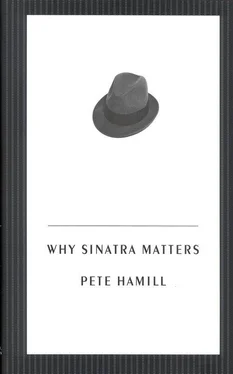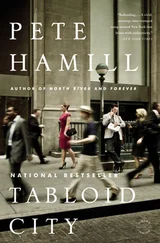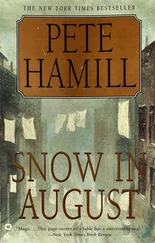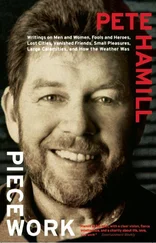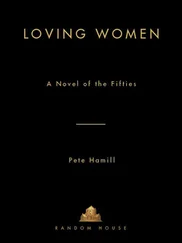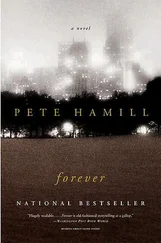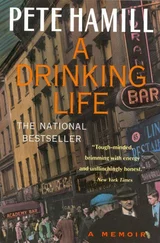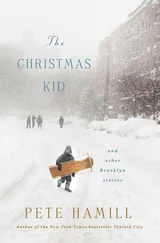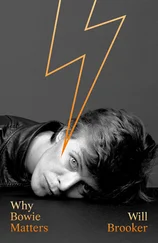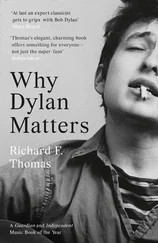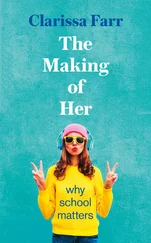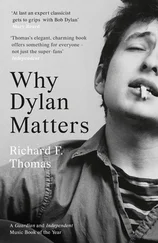The male anger against Sinatra came to a head in October 1944, when he played the Paramount again and 30,000 mostly female fans erupted into a small riot outside the theater. When a male dissenter in the Paramount balcony fired a tomato at the stage, he had to be rescued from women who were trying to beat him to death. Breathless accounts of these events were all over the newspapers and the radio. At the same time, the first V-2 rockets were falling on London and American troops were fighting their way into Germany, taking heavy casualties. In our neighborhood, where the war was not a distant abstraction, the phenomenon of young Frank Sinatra was discussed with much heat in the bars and on the street corners and in the kitchens.
I don’t get it, my father would say. All those girls going nuts for a draft dodger.
He’s not a draft dodger, my mother would say. He’s 4-F. He’s got a punctured eardrum. He tried to join three times, and they turned him down. It was in the papers.
The papers, he sneered. You believe the papers?
Flying north from Florida, I could remember all that argument and my own youthful wonder about its passion. At nine, I was too young to understand what Sinatra was doing with his music. I did know it was different. Crosby made us feel comfortable and, in some larger way, American . But there was a tension in Sinatra, an anxiety that we were too young to name but old enough to feel. During the last six months of the European war, when men were dying by the thousands in the Battle of the Bulge, it was confusing to hear songs that contained so much anguish. Or loss. Or loneliness. I would see young women pushing strollers along the avenue, their men off at war, see them pausing to look at the front pages on the newsstands, see the way their faces clenched, and I wished that Bing Crosby could sing to them and make them feel better. It took me a long while to understand that it was Frank Sinatra who was giving words and voice to the emotions of their own roiled hearts.
III . Years later, when I was a reporter and then a columnist for Dorothy Schiff’s New York Post , I got to know Sinatra. Cannon introduced me to him after the Floyd Patterson — Sonny Liston fight in Las Vegas in 1963. We were together on other evenings. On the surface, this seemed strange, another contradiction in the character of a man dense with contradictions. Sinatra had wasted too much of his adult life in vicious quarrels with newspapermen and gossip columnists, had punched out at least one columnist (the awful Lee Mortimer), and was continually in rumbles with paparazzi.
“Sinatra’s idea of paradise is a place where there are plenty of women and no newspapermen,” said Humphrey Bogart, who was sixteen years older than the singer and a kind of hero to the younger man. “He doesn’t know it, but he’d be better off if it were the other way around.”
Perhaps, as he moved toward sixty, Sinatra came to understand what Bogart meant. Certainly, when he was in New York, he sought out his favorite newspapermen. Cannon was his friend, while the rest of us were friendly acquaintances. Cannon was only five years older than Sinatra, a New Yorker shaped by Prohibition and the Depression, the myth of 1930s Broadway, and World War II in Europe, where he served as a correspondent for Stars and Stripes . They spoke the same language, shared passions for boxers, ballplayers, and beautiful women. Cannon brought a poetic language to his sports columns, some of which were shaped like songs, and his essentially romantic vision of that world was saved from sentimentality by a knowing New York tone. Like Sinatra, he was afflicted by insomnia and bouts of personal loneliness; he read widely and intelligently, deep into the night. Sinatra never gave up the whiskey, but he was a reader too; he and Cannon talked at all hours of the night about books, and it was Cannon who urged him to read Nelson Algren’s The Man with the Golden Arm , which was the basis of one of Sinatra’s finest movies. It didn’t matter where they were staying; insomniacs without wives can always be reached by phone.
Cannon also got Sinatra to read Murray Kempton, who was writing his brilliant column for the New York Post in the same years that Cannon was the star of the sports section. Kempton was an absolute original who brought a unique, mandarin style to newspapers; on some days it was as if Henry James had agreed to cover the longshoremen’s union. He had an extraordinary sympathy for rascals, outcasts, those subjected to lofty moralizing. Nobody ever wrote more intelligently about Sinatra than Kempton did in a handful of columns across the years. But Kempton, who also liked his whiskey, was not a man who moved easily through the night. It was hard to imagine him sitting around in saloons. But Sinatra loved his work and would have his columns (and Cannon’s) airmailed to him each day in California. “The man is a marvel,” he said to me once about Kempton. “It’s like listening to Louis Armstrong, or Roy Eldridge: you don’t know where the hell he is going, but somehow he gets there and it knocks your socks off.” He made certain that Kempton covered the 1961 inaugural party for John F. Kennedy, which Sinatra produced. He joined him occasionally at more formal parties in New York, sometimes at his own apartment on East Seventy-second Street, near Third Avenue. He sent him fan mail, which he signed “Francis Albert.” But he didn’t call much on the telephone. “Kempton is one of those guys,” he explained, “that makes me feel tongue-tied.”
I was twenty years younger than Sinatra, but he seemed to be comfortable when I was around. It certainly helped that Cannon and Shirley MacLaine had vouched for me, and he was impressed that I knew Kempton. There might have been one other factor: Cannon and I were both high school dropouts, as was Sinatra. (Oddly, Cannon and I had dropped out of the same institution, a great Jesuit high school called Regis.) This might have meant more to Sinatra than it did to us; in a very important way he defined success as a triumph over the odds.
“Every time they print your column,” he said to me once, “you are getting your fucking diploma.”
I laughed. But he was serious.
Later, Sinatra had one other newspaper friend, Sidney Zion, now a fine columnist for the New York Daily News . Zion came out of Paterson, New Jersey, went to law school, worked as a prosecutor, and then became a reporter for the New York Post . Like all of us at the paper, he worshiped Kempton. But he had been shaped by the traditions and lore of urban New Jersey. The figure of Frank Sinatra was an immense part of that tradition. Zion loved the music that Sinatra loved most, the music of the hours after midnight. He loved saloons. He loved smoking and drinking (and still does). He is a wonderful storyteller.
“I got to know him around 1980, the time of the Trilogy album,” Zion told me. “I did a piece about the old music for the Times , and one thing led to another. A mutual friend introduced us, and I’d see him when he was in New York. I think he liked me because he’d never met a Jew who drank as much as I did.”
Sinatra was always more cynical about the Hollywood press corps. He thought most of them were freeloaders, or on the take. “I’ve seen the bills, baby,” he said once about reporters and columnists who took money from the publicity budgets of the studios. In his early years he had cooperated with the fan magazines and other components of the Hollywood publicity machine. At some points he had even groveled to the more powerful columnists when advised to do so (although the most powerful columnist of all, Walter Winchell, never joined in the attacks on Sinatra). But from the mid-1950s until his death, he worked with the press only on his own terms.
Читать дальше
